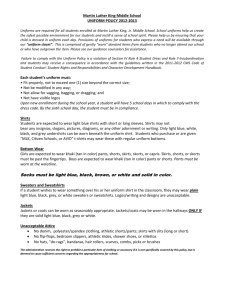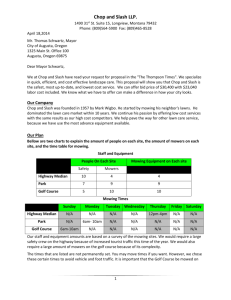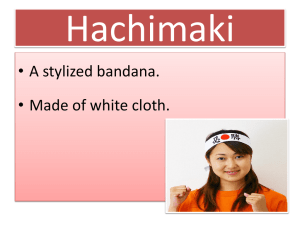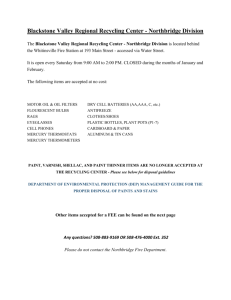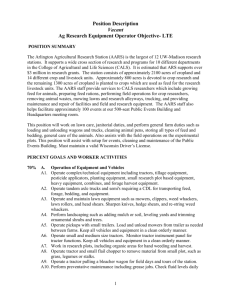GROUNDS, LAWN CARE AND MOWING SAFETY
advertisement
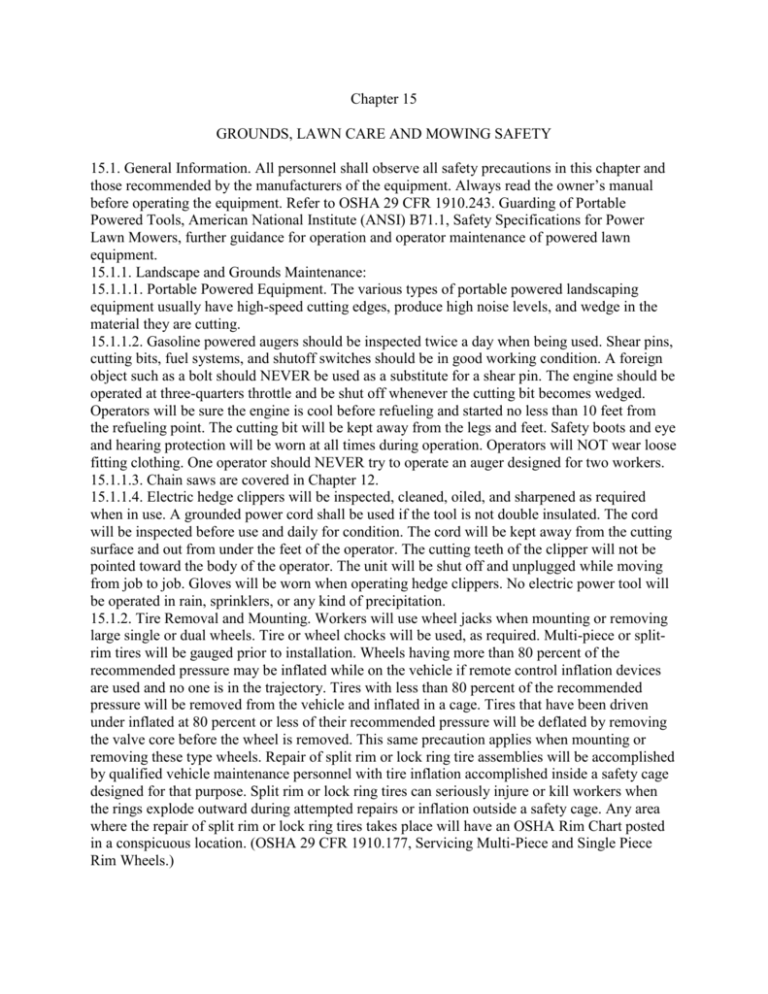
Chapter 15 GROUNDS, LAWN CARE AND MOWING SAFETY 15.1. General Information. All personnel shall observe all safety precautions in this chapter and those recommended by the manufacturers of the equipment. Always read the owner’s manual before operating the equipment. Refer to OSHA 29 CFR 1910.243. Guarding of Portable Powered Tools, American National Institute (ANSI) B71.1, Safety Specifications for Power Lawn Mowers, further guidance for operation and operator maintenance of powered lawn equipment. 15.1.1. Landscape and Grounds Maintenance: 15.1.1.1. Portable Powered Equipment. The various types of portable powered landscaping equipment usually have high-speed cutting edges, produce high noise levels, and wedge in the material they are cutting. 15.1.1.2. Gasoline powered augers should be inspected twice a day when being used. Shear pins, cutting bits, fuel systems, and shutoff switches should be in good working condition. A foreign object such as a bolt should NEVER be used as a substitute for a shear pin. The engine should be operated at three-quarters throttle and be shut off whenever the cutting bit becomes wedged. Operators will be sure the engine is cool before refueling and started no less than 10 feet from the refueling point. The cutting bit will be kept away from the legs and feet. Safety boots and eye and hearing protection will be worn at all times during operation. Operators will NOT wear loose fitting clothing. One operator should NEVER try to operate an auger designed for two workers. 15.1.1.3. Chain saws are covered in Chapter 12. 15.1.1.4. Electric hedge clippers will be inspected, cleaned, oiled, and sharpened as required when in use. A grounded power cord shall be used if the tool is not double insulated. The cord will be inspected before use and daily for condition. The cord will be kept away from the cutting surface and out from under the feet of the operator. The cutting teeth of the clipper will not be pointed toward the body of the operator. The unit will be shut off and unplugged while moving from job to job. Gloves will be worn when operating hedge clippers. No electric power tool will be operated in rain, sprinklers, or any kind of precipitation. 15.1.2. Tire Removal and Mounting. Workers will use wheel jacks when mounting or removing large single or dual wheels. Tire or wheel chocks will be used, as required. Multi-piece or splitrim tires will be gauged prior to installation. Wheels having more than 80 percent of the recommended pressure may be inflated while on the vehicle if remote control inflation devices are used and no one is in the trajectory. Tires with less than 80 percent of the recommended pressure will be removed from the vehicle and inflated in a cage. Tires that have been driven under inflated at 80 percent or less of their recommended pressure will be deflated by removing the valve core before the wheel is removed. This same precaution applies when mounting or removing these type wheels. Repair of split rim or lock ring tire assemblies will be accomplished by qualified vehicle maintenance personnel with tire inflation accomplished inside a safety cage designed for that purpose. Split rim or lock ring tires can seriously injure or kill workers when the rings explode outward during attempted repairs or inflation outside a safety cage. Any area where the repair of split rim or lock ring tires takes place will have an OSHA Rim Chart posted in a conspicuous location. (OSHA 29 CFR 1910.177, Servicing Multi-Piece and Single Piece Rim Wheels.) 15.1.2.1. Mowing. Maintenance of installation grounds involves the use of various sizes and types of lawnmowers. The two basic industrial types are reel and rotating that may be pushed, self-propelled, ridden, or towed. The most significant dangers are being struck by the blade or a foreign object thrown by the high speed blades and noise-induced hearing loss. NOTES: 1. All personnel shall observe the safety precautions in this standard and those recommended by the manufacturer of the equipment. Always read the owner’s manual before operating the equipment. 2. Ensure electric mowers, trimmers, and attached extension cords are effectively grounded. However, listed or labeled portable tools protected by an approved system of double insulation, or its equivalent, need not be grounded. 3. Never use electric mowers and grass trimmers while it is raining or the grass is wet, excluding light dew. 15.1.3. Foot Protection. Workers will wear safety-toe shoes or metal toe-guards when operating powered push mowers or edgers. When using mowers equipped with an installed rear drag plate or edgers with nylon filament line cutters (and requirements of paragraph 15.1.2.1. are followed) the use of safety-toe shoes or metal toe-guards is optional. In all instances, workers operating this equipment will wear shoes of sturdy construction. Open-toed sandals, tennis shoes constructed of cloth or canvas, etc., are not appropriate for wear during mowing tasks. 15.1.3.1. Eye Protection. Use suitable eye protection (safety glasses, goggles, face shields, or a combination) when operating powered edgers or weed eaters. When mower operators are exposed to flying rocks, dirt, or other hazards, they will wear appropriate eye protection. 15.1.3.2. Hearing Protection. If hazardous noise levels are produced by the equipment being operated, workers will wear hearing protection. Coordinate with the EH&S Department for guidance. If equipment is identified as producing hazardous noise levels, place a decal or stenciled warning in view of the operator stating: “WARNING—THIS MACHINE CREATES HAZARDOUS NOISE LEVELS. EAR PLUGS OR MUFFS SHALL BE WORN.” 15.1.3.3. Other. Workers may wear gloves when using walk-behind mowers. In addition, they should wear bump caps when using a riding or towed mower around tall brush and low hanging tree limbs. Guard all mower discharge chutes with shields or approved grass catchers to deflect or stop foreign objects thrown and to prevent the operator’s inadvertent contact with the blade during operation. Place a readable safety message indicating “CAUTION ,” “WARNING ,” or “DANGER—DO NOT USE WITHOUT GUARD OR GRASS CATCHER IN PLACE ” on or near the mower’s discharge opening. NOTE: Push and self-propelled mowers manufactured according to ANSI B71.1, Lawn Mowers, Lawn and Garden Tractors, and Lawn Tractors, are equipped with a rear protective guard. 15.1.4. Operating Practices Applicable to Powered Push Mowers: 15.1.4.1. Prior to mowing, operators will clear the area to be mowed of all people and inspect for foreign objects, raised sprinkler heads, holes, soft ground, obstructions or any other condition that has the potential to impact the safety of the operation. 15.1.4.2. Personnel operating this equipment should never pull the mower backwards while the engine is running because the safety guard on the back may cause the mower to lift off the ground subjecting the operator to serious injury. 15.1.4.3. Always mow in a horizontal direction across the face of a steep slope, e.g., hills or banks exceeding a 30-degree angle, and keep firm footing at all times. 15.1.4.4. Stay clear of the front of self-propelled mowers during and after starting. Control the mower by hand pressure on the handle, not by foot pressure on the housing. 15.1.4.5. Do not attempt to clean grass from the chute when the mower is running. Disconnect the spark plug or if electrical—the power—when cleaning, repairing, or inspecting the mower. 15.1.4.6. Do not leave the mower running unattended. 15.1.4.7. Set mower height no lower than recommended by the Supervisor, Grounds Manager or local policy for turf maintenance. 15.1.4.8. Powered Mowers—Walk-Behind, Riding-Rotary, Converted Sulky, and Reel Power Lawnmowers. These mowers shall meet the design specifications NOTE: in OSHA Standard 29 CFR 1910.243, Guarding of Portable Powered Tools. (For example: “Deadman controls shall automatically interrupt power to a drive when the operator’s actuating force is removed, and may operate in any direction to disengage the drive.”) 15.1.4.9. Follow manufacturer’s requirements during vertical or horizontal mowing of grades with riding or towed mowers. 15.1.4.10. While operating gang reel mowers on a slope, raise the upper reels as a counterbalance to prevent the mower from sliding or turning over. Ensure special equipment designed for steep hills or grades is available or workers can cut by hand using manual tools. 15.1.4.11. Edgers. Check to make sure the guard is in place. Never use the edger when people are in line with the blade. Use proper PPE. Always disconnect power when inspecting or repairing the edger. 15.1.5. General Rules for Maintaining Lawn Care Equipment: 15.1.5.1. Always refuel with the engine off and allow the engine to cool first. Do not permit smoking in the area. Refuel mowers prior to use instead of refueling before storing inside a building. Complete refueling outside at least 10 feet away from the building or any open flame source. 15.1.5.2. Use boards or ramps to load and unload mowers from vehicles. Ensure the engine is off and the spark plug wire is disconnected. Always shut off the fuel supply line when parking mowers inside or outside at the end of the duty day. As storage space permits, leave 1- to 3-feet separation space between parked gasoline-operated riding mowers. 15.1.5.3. Clean mowers or perform other maintenance on mowers only after turning the engine off and disconnecting the spark plug wire. 15.1.5.4. Use manufacturer’s guidelines for operation and use of mowers. 15.1.6. Batteries: 15.1.6.1. Protective clothing will be used when servicing batteries. As minimum, safety-toe shoes, suitable eye and face protection, a rubber apron, and rubber gloves will be worn. 15.1.6.2. Personnel will use battery straps and PPE when lifting and carrying batteries. Where straps cannot be used, workers will practice correct lifting procedures to prevent strains from improper lifting. Batteries that cannot be carried with straps will be transported with carts or other material handling equipment. 15.1.6.3. Nickel-cadmium and unsealed lead-acid batteries will be separated to keep the leadacid fumes away from the nickel-cadmium batteries. 15.1.6.4. Tools or metal parts will not be laid on a battery or stored where they may fall on a battery. 15.1.6.5. Workers will not wear rings, watches, bracelets, or other jewelry when working with batteries. Metal eyeglasses will be secured by a band or cord. 15.1.6.6. Battery charging will be done in specifically designated areas. The Environmental Health & Safety Department will be contacted to evaluate the ventilation system for these designated areas. Where batteries are serviced, methods will be provided for flushing and neutralizing spilled electrolyte. Adequate ventilation will be provided to prevent hydrogen gas buildup (unsealed lead-acid batteries) and an ample supply soda ash (or similar) will be available for quick absorption of the work area if acid is splashed or spilled. Personnel assigned to work with batteries will be instructed in emergency procedures such as coping with electrolyte spills. Where required, a serviceable emergency eyewash will be present in the shop area (refer to Chapter 19, Emergency Shower and Eyewash Units). 15.1.7. Tractor Operations. There are regulatory OSHA standards covering agricultural tractors. While limited in scope, these standards do contain some provisions applicable to tractors used in landscaping operations. Regulatory OSHA requirements from OSHA 29 CFR 1926.1002, Protective Frames (ROPS) Test Procedures and Performance Requirements for Wheel-Type Agricultural and Industrial Tractors Used in Construction are covered in paragraphs 15.1.7.1. and 15.1.7.2. 15.1.7.1. Roll-over protective structures (ROPS) are required on tractors used for landscape maintenance. Seat belts shall be installed on all ROPS-equipped tractors and used whenever the vehicle is in motion. 15.1.7.2. Commercially purchased ROPS will satisfactorily pass the field upset tests (side and rear) specified in OSHA 29 CFR 1926.1002. A label indicating this is permanently attached by the manufacturer to the ROPS. 15.1.7.3. When pulling a load, operators will hitch only to the draw bar. The draw bar hitch will be kept at least 13 inches, but less than 17 inches, off the ground. 15.1.7.4. When moving a front load, the load will be kept low to the ground and the rear wheels as level as possible. 15.1.7.5. Operators will avoid holes and obstacles; both on the ground and overhead. Speed will be reduced with heavy loads when vision is limited or when operating on rough terrain. 15.1.7.6. When stuck, operators will try carefully to back out. Increasing engine speed or fastening a post to the rear wheels greatly increases the chances of tipping over backward; therefore, these methods will not be used. Operators will get help if needed. 15.1.7.7. When traveling on highways, operators will abide by local traffic rules. They will avoid travel during heavy traffic periods and check brakes for equal application for highway use. The lighting and markings required by local state vehicle codes will be used. Slow-moving vehicle emblems will be used. 15.1.7.8. Grass will not be mowed with a tractor on slopes greater than a 4-inch rise or drop per foot of travel. Lower gears will be used when going down hill and the wheels will be allowed to control the tractor speed. 15.1.7.9. When using a sickle-bar mower, the sickle-bar blades will not be positioned downhill. They will be positioned on the upper side of the slope so the pull of gravity will not cause the tractor to turn over. 15.1.7.10. The engine will be shut off before the operator dismounts from the tractor or makes adjustments to either the tractor or towed equipment. 15.1.7.11. Riders will not be allowed on tractors, the draw bar, or towed equipment, except where the equipment is specifically designed to allow riders or passengers. 15.1.7.12. Fenders are guards for the worker’s protection. Fenders will be kept in place at all times. 15.1.7.13. Tractors will only be left on an incline after the engine has been turned off, gear shift has been placed in park position (or the lowest gear if standard transmission), and the wheels have been braked and blocked. Where possible, tractors will be parked on level ground. 15.1.7.14. The power take-off guard will always be in place. 15.1.7.15. An operator will dismount or mount a tractor only when it is stopped. The steps and platform will be kept clean of debris. 15.1.7.16. Hearing protection and safety-toe shoes will be worn by the operator, when required. When operating in an overhead hazard area, hard hats will be worn. 15.1.8. Maintenance of Irrigation Systems: 15.1.8.1. Gases, low oxygen levels, high water levels, and in some cases, pressure are some hazards that exist in irrigation pits. Before entering an irrigation pit, oxygen and combustible gas levels shall be tested. Potential cracks, leaks, and weak pipes may be discovered. Upon finding any of these conditions, the pit will be ventilated and the worn or broken parts replaced before use of the pit is permitted. Before commencing repair work, the worker will ensure the water and electrical power have been turned off. 15.1.8.2. Only qualified electricians will work on electrical systems. 15.1.8.3. Transformers and other electrical equipment will be protected in waterproof boxes. Timing mechanisms will be mounted in a locked box. 15.1.8.4. Safety glasses or goggles and safety-toe shoes or boots will be worn during maintenance operations. Reflective safety vests will be worn when working within 15 feet of a roadway or parking lot. The safety vest should contain at least 30 square inches of reflective material. When working on or at the edge of a roadway, cones or barricades with lights and traffic warning signs will be used. 15.1.9. Tree Maintenance: 15.1.9.1. Routine, unscheduled, and emergency conditions will normally require tree care maintenance throughout the year. Only trained and certified personnel will perform tree work, this includes work accomplished during adverse weather conditions. All workers will receive training in emergency rescue and life saving first aid techniques. 15.1.9.2. Two or more workers and an on-site job supervisor, fully qualified in tree maintenance, shall be assigned when tree maintenance involves climbing, working from a high reach lift, and while cutting down any tree other than small low trees that would pose no hazards to people, facilities, and utility lines. The area around trees that are being trimmed or cut and in the vicinity of operating chippers and stump grinders shall be effectively marked with cones, streamers, or barricades and controlled to warn personnel against the danger of entry. 15.1.9.3. Safety belts, saddles, ropes, D-rings, cutting tools, equipment, and all other related climbing gear will be inspected to ensure it is in safe condition prior to each use. Any equipment or climbing gear that is frayed, worn, broken, or defective shall be removed from service immediately. Each climber will have at least one lifeline and one hand line, normally nylon, onehalf inch by 125 feet. At least two, three-fourths of an inch polypropylene or equivalent lines (250 feet long each) will be provided for each crew. The nominal breaking strength of one-half inch ropes used for climbing shall not be less than 2,385 pounds. Climbing and safety ropes shall not be spliced for repair or added length. The ends of ropes will be wrapped to prevent fraying. A climbing rope shall always be used, even when work is performed from a ladder or lift device. 15.1.9.4. Workers involved in tree maintenance shall wear hard hats, gauntlet gloves, eye protection, and high-top safety boots when operating power saws or equipment. Hearing protection will be worn where hazardous noise level sources, such as power chain saws, chippers, and stump grinders, are operating. Ballistic nylon patch leg coverings should be used while operating power chain saws. Clothing for tree-climbing operations will be long sleeve shirts, pants, and clothing that is not baggy or loose. 15.1.9.5. Supervisors will complete (and have available for use) local operating instructions for both routine and emergency tree maintenance operations. Critical elements with serious potential to affect workers’ safety, such as tree climbing, tree cutting and removal, trimming near electrical lines, use of chain saws, use of high-reach lifts, and use of cutters or chipper equipment, will be included. 15.1.9.6. Additional general safety requirements for tree care operations can be found in ANSI Z133.1, Tree Care Operations—Pruning, Trimming, Repairing, Maintaining, and Removing Trees, and Cutting Brush—Safety Requirements. 15.1.10. Flower Bed and Shrub Maintenance: 15.1.10.1. All flowers and shrubs will be planted and maintained at a height that will not interfere with the vision of vehicle operators. Workers will wear clothing and gloves that will protect their hands and arms from thorns and leaves which may cut or puncture the skin. Form fitting face piece devices may be required to prevent reactions to fine dust or pollen. Personnel will not work on flower or shrub beds within 24 hours after application of herbicides. 15.1.10.2. Rototillers and other machines used for preparing or maintaining beds will be fueled, lubed, and inspected daily to ensure safe operation. Workers will keep their feet and hands clear of moving parts and will not wear loose clothing. Shovels, hoes, and cultivators will be kept sharp, used in moist soil, and placed where stepping on the cutting surface will not cause the handle to strike a person. Poisonous plants will not be planted. 15.1.10.3. Edging. Edging is done either by hand or with a machine. This standard primarily covers edging with a machine because of the hazards involved. 15.1.10.4. Be familiar with the machine before attempting to operate it. Keep the area clear of all persons. Inspect the area and remove all foreign objects. Ensure the edging is not of a depth along walks to create a hazard for pedestrians. 15.1.10.5. Wear goggles, gloves, and safety-toe boots when operating a powered edger. Only gloves are required for using a manual edger. Wear the orange safety vest when edging requires the worker to be in the roadway or near the edge of a non-curb protected road. 15.1.10.6. Exercise caution to avoid slipping or falling on slopes. 15.1.10.7. Stop the engine and let it cool before adding fuel. Wipe up any spilled fuel before restarting the engine and replace fuel caps securely. Never store a fueled edger inside a facility where an open flame or an ignition source may be present. 15.1.10.8. Use a grounded three-wire cord for electrical driven edgers that are not double insulated. 15.1.10.9. Do not make adjustments when the engine is running. 15.1.10.10. Stay alert for hidden hazards. After striking a foreign object, stop the engine, remove the wire from the spark plug, and repair the damage before resuming operations. Remove the spark plug wire whenever it is necessary to put the hands close to parts that move. 15.1.11. Reseeding: 15.1.11.1. Seeders and rototillers have moving parts and create large amounts of dust. Safety protectors such as gloves, approved respirators or dust masks, safety glasses or goggles, and safety-toe shoes or boots will be worn. 15.1.11.2. When working on slopes, the worker will have firm footing at all times. Reflective safety vests will be worn when working next to any non-curb protected type of roadway. 15.1.12. Sodding: 15.1.12.1. Back strains, twisted ankles, and cuts can result from this type of operation. When sod is too bulky to allow two workers to handle, use a wheelbarrow or other equipment. Follow the lifting guidelines in paragraph 4.6. of this standard. When cutting sod, cut away from yourself and do not make hacking motions. 15.1.12.2. Powered rollers and hand rollers are both used in sodding. Powered rollers are heavy and slip easily on slopes. When using a powered roller, avoid steep slopes so the roller does not tip or slide. Keep hands and feet away from moving parts. Push or pull hand rollers. When rolling sod on a slope, tie a rope to the handle, pull the roller up the hill, and let it roll down the hill by gravity. Do not walk on the slope while using a hand rollers. 15.1.13. Fertilizer Storage and Handling: 15.1.13.1. Fertilizer can become a very combustible material and may explode if stored at temperatures in excess of 130 degrees F. When fertilizers become wet and start to decompose, they give off gas that will burn. Some fertilizers give off very toxic gases when burning. When fertilizer has started to burn, a large quantity of water should be applied to the burning surface to extinguish the flame and cool the rest of the fertilizer. The fire department shall be notified of any evidence of heating, smoking, combustion, or fire in the fertilizer. No more than 60 tons of fertilizer (mixtures containing 60 percents or more by weight or ammonium nitrate) will be stored in a location unless the location and storage facility have been approved by the EH&S department and the fire department. 15.1.13.2. When spreading fertilizer, pellets will not be directed toward other people. If personnel enter the area, the spreader will be turned off. Fertilizer spreaders will be cleaned and lubricated daily. Safety glasses and gloves will be worn during fertilizing spreading operations. 15.1.13.3. Herbicides. The use of herbicides for weed control poses a significant potential safety and health hazard. Herbicides shall be applied per manufacturer’s instructions and used only by certified personnel. Due to the absorption properties of herbicides, coveralls will be worn during application, in addition to safety goggles and appropriate respiratory protection, as determined by EH&S Department.
